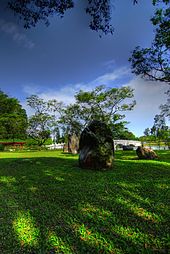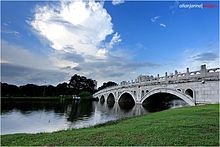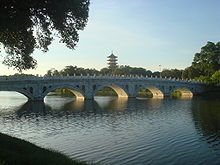- Chinese Garden, Singapore
-
Chinese Garden (Chinese: 裕华园), also commonly known as Jurong Gardens, is a park in Jurong East, Singapore. Built in 1975 and designed by Prof. Yuen-chen Yu, an architect from Taiwan, the Chinese Garden’s concept is based on Chinese gardening art. The main characteristic is the integration of splendid architectural features with the natural environment. The Chinese Garden is modeled along the northern Chinese imperial style of architecture and landscaping. It is located next to Chinese Garden MRT Station and connected to the adjacent Japanese Garden by a bridge.
Contents
Features
Stone Lion
It is a Chinese belief that the lion is the animal representing authority and fealty. Thus, the cloudy-grained marble stone lions at the gates of the Chinese Garden – typically Chinese in style – guarding the main gates of the Garden. They are skilfully sculptured from Taiwan-imported marble stone.
Bridge
In the art of Chinese gardens, bridges play an imtant ro the most important structures and may denote the character.
The ‘Pai Hung Ch’iao’ Bridge (the white rainbow, 13-Arch Bridge) at the Garden follows the style of the 17-Arch Bridge at the Summer Palace in Peking. Although the bridge at the Chinese Garden is shorter than the famous 17-Arch Bridge, it still maintains the magnificence and brilliance in architectural design, representing a typical beautiful Chinese bridge.
The Rainbow Bridge is the finish line of The Amazing Race Asia 2.
Main Arch Building
It is a renowned and typical Chinese arch building. The magnificent and grandiose form has made it very popular for picture-taking.
Inside the main arch building, there is two courtyards, namely the “Early Spring Courtyard” and “Garden Courtyard”. Also, there is a fishpond in the centre which is named the “Fishes Paradise”.
Stone Boat and Tea House
A famous traditional feature of Chinese architecture is the Stone Boat structure. Its unique design and splendid architectural beauty is a fine art which has long been praised by people throughout the world.
The style of ‘Yao-Yueh Fang’ (the Stone Boat) in the Chinese Garden is based on the Peking style, but there are some adaptations in the design and the materials used here – as a result of which – a more beautiful and grandiose form is obtained.
The ‘Ming Hsiang Hsieh’ (Tea House) is a miniature structure following the style of the elaborate, winding gallery at the Summer Palace. This meandering design is a characteristic and graceful Chinese architectural feature.
Pagoda
In ancient times, the pagoda, originally a simple tower located beside a temple, was used for the keeping of human bones by Buddhists. Later, with improvements in architectural skills, incorporated with the traditional art of building, the pagoda was developed into a structure of striking architectural beauty.
The ‘Ru Yun T’a) (7-storey pagoda) is situated on a small hill in the Chinese Garden. Its typical pagoda design follows the style of Ling Ku Temple Pagoda at Nanjing.
Pavilion, Plateau, Tower
The Chinese Pavilion, Plateau and Tower represent the soul of the Chinese gardening art. The artistic features, typical of Chinese architecture have long been appreciated by man. The arrangement of these structures is very important and one of the essential rules of the structural arrangement is that the position of each structure must be balanced by its height and size. Further, the building must be linked with plants, rocks, a winding stream and footpaths so as to create a poetical scene.
The design of the four pavilions at the Chinese Garden is based on the style of Northern Chinese Pavilions, and decorated to blend harmoniously with the Garden.
Bonsai Garden
Opened in June 1992, the Suzhou-style Bonsai Garden cost an estimate $3.8 million to build. This 5,800-square-metre garden with Suzhou-style buildings (incorporating a main hall of 50 square metres) and landscape houses a collection of over 2,000 bonsais imported from China and other parts of the world.
The Bonsai Garden has since taken on a new look. Newly revitalised, after spending an estimate of another $500,000 - the Bonsai Garden is a beauty that must be seen to be believed. It is designed as a largest Suzhou-style Bonsai garden of its kind outside of China.[citation needed]
A Bonsai Training Centre has been launched. The public are encouraged to sign up for the course, which will be taught by our resident Bonsai experts from Shanghai and Suzhou (China). They will teach on how to prune and care for Bonsais and how to appreciate the beauty of this unique artistry.
Garden of Abundance
The newest addition to the Chinese Garden family is the Garden of Abundance. The original name of this garden is the Zodiac & Pomegranate Garden, derived from the elements used for the construction of the garden.
It consists of pomegranate trees, the 12 Chinese Zodiac animals sculpture, a sundial, stone bridges and planting of materials, which have meanings of longevity, abundance and fulfilment. Hence the name Garden of Abundance was selected.
100-year-old pomegranate trees from Shantung, China have been carefully planted into this new garden. It sits among the 12 Chinese Zodiac Animal sculptures. This creative concept of Chinese Garden is a new scenic spot designed according to Chinese tradition and folk culture. And most importantly, the theme and design of this garden bestows sincere wishes dedicated to the visitor.
The Live Turtle & Tortoise Museum
The Live Turtle and Tortoise Museum exhibits different species turtles and tortoises. A highlight of the museum is it exhibits exotic types of tortoises, such as tortoises with 2 heads and 6 legs - where only one in every few million of these rare species will survive.
You Yuan Buffet & Seafood Restaurant
Serving all kinds of seafood, southern and northern China cooking, Peking, Szechuan and Cantonese cuisine, You Yuan Seafood Restaurant sits on the Stone Boat, overlooking the calming waters. With the new boardwalk so that diners can go alfresco under the stars. There is also a dancing arena and karaoke, set in classy, unique traditional Chinese theme. It is open for both lunch and dinner.
The East Entrance
This entrance was specially constructed in conjunction with the Chinese Garden MRT station, to ensure easy access for pedestrians visiting the gardens. Upon approaching the garden, there is a Red Bridge that will lead you in. This Red Bridge symbolises good luck and is an auspicious colour for the Chinese. Two stone lions, welcoming the visitors before entering the garden, also guard the entrance.
External links
- 360° X 360° Interactive VR of the Singapore Chinese Gardens
- Singapore-attractions: Jurong Gardens
- Visit Singapore
Islands of Singapore Natural Pedra Branca · Pulau Anak Bukom · Pulau Bajau · Pulau Berkas · Pulau Biola (Violin Island) · Pulau Brani · Pulau Buaya · Pulau Bukom / Pulau Bukum · Pulau Bukom Kechil/Pulau Bukum Kechil · Pulau Buloh · Pulau Busing · Pulau Damar Laut · Pulau Damien · Pulau Hantu (Ghost Island) · Pulau Jong (Junk Island) · Pulau Keppel · Pulau Ketam · Pulau Khatib Bongsu · Pulau Malang Siajar · Pulau Palawan · Pulau Pawai · Pulau Pergam · Pulau Renggis · Pulau Sakijang Bendera (St. John's Island) · Pulau Sakijang Pelepah (Lazarus Island) · Pulau Salu · Pulau Samulun · Pulau Sarimbun · Pulau Satumu (One Tree Island) · Pulau Sebarok (Middle Island) · Pulau Seletar · Pulau Semakau · Pulau Senang (Barn Island) · Pulau Sekudu (Frog Island) · Pulau Selugu (Sarong Island) · Pulau Serangoon (Coney Island) · Pulau Seringat · Pulau Seringat Kechil · Pulau Subar Darat (Sisters' Islands) · Pulau Subar Laut (Sisters' Islands) · Pulau Sudong · Pulau Tekong · Pulau Tekukor · Pulau Tembakul (Kusu Island / Peak Island) · Pulau Ubin · Pulau Ular · Pulau Unum · Sentosa · Singapore (Pulau Ujong) · Sultan ShoalArtificial Chinese Garden · Coral Island · Japanese Garden · Jurong Island · Kias Island · Paradise Island · Pearl Island · Pulau Punggol Barat · Pulau Punggol Timor · Sandy Island · Treasure IslandFormer Anak Pulau · Berhala Reping · Pulau Ayer Chawan · Pulau Ayer Merbau · Pulau Bakau · Pulau Darat · Pulau Merlimau · Pulau Mesemut Darat · Pulau Mesemut Laut · Pulau Meskol · Pulau Pesek · Pulau Pesek Kecil · Pulau Saigon · Pulau Sejahat · Pulau Sejahat Kechil · Pulau Sakeng / Pulau Seking · Pulau Sakra · Pulau Sanyongkong · Pulau Semechek · Pulau Seraya · Pulau Tekong Kechil · Terumbu Retan LautNo longer part of Singapore Categories:- Parks in Singapore
- Visitor attractions in Singapore
- 1975 establishments
- Jurong East
Wikimedia Foundation. 2010.




